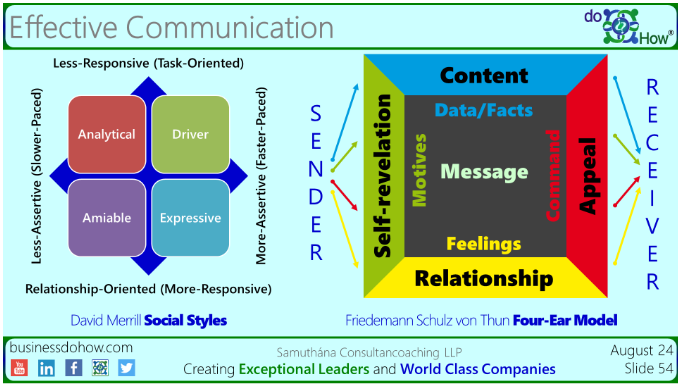Effective Communication by Dinakar Murthy

Communication is the lifeblood of human interaction. Whether we’re navigating professional relationships, collaborating with colleagues, or connecting with loved ones, understanding how we communicate—and how others receive our messages—can profoundly impact our success and well-being. In this article, I will explore two powerful models that shed light on communication dynamics: the Social Styles model and the Four Ear model. These frameworks provide valuable insights into our own communication tendencies and equip us to engage more effectively with others.
Social Styles Model
The Social Styles model categorizes people based on their communication behaviors. Developed by David Merrill, this model identifies four distinct social styles:
- Drivers: Task-oriented, assertive, and fast-paced individuals who thrive on efficiency and results.
- Analyticals: Detail-oriented and slower-paced, prioritizing accuracy and logic. They appreciate thorough information.
- Amiables: Relationship-oriented and empathetic, valuing harmony and collaboration. They seek to build connections.
- Expressives: Enthusiastic, outgoing, and relationship-oriented, loving to inspire and motivate others.
Four Ear Model
The Four Ear model, developed by Friedemann Schulz von Thun, encourages us to listen with multiple perspectives:
- Factual Ear: Focuses on the content—the data, facts, and information being communicated.
- Self-Revealing Ear: Considers what the speaker reveals about themselves—their emotions, motives, and personal context.
- Relationship Ear: Tunes in to the relational aspect. Tone, feelings, and the overall relationship between speaker and listener matter.
- Appeal Ear: Pays attention to any requests or commands embedded in the message.
Applications of Social Styles and Four Ear Model for Communicating Effectively
Adaptation: Recognizing someone’s dominant social style allows us to tailor our communication. Adjusting our approach—whether concise for drivers, detailed for analyticals, empathetic for amiables, or enthusiastic for expressives—enhances understanding.
Team Dynamics: In teams, understanding social styles fosters collaboration. Imagine a driver working with an expressive—they can adapt their pace and tone to create synergy.
Sales and Negotiation: Salespeople and negotiators can use social styles to connect with clients. Adapting language and approach based on the client’s style leads to better outcomes.
Enhanced Listening: By considering all four ears, we gain a richer understanding of messages. Active listening becomes a powerful tool.
Conflict Resolution: When conflicts arise, analyzing communication through the Four Ear model helps identify underlying issues. Misunderstandings often stem from different interpretations across the ears.
Feedback and Coaching: Managers can use this model to provide effective feedback. Addressing factual content, emotions, and relational aspects ensures a comprehensive evaluation.
Conclusion
Many of these models will make a lot of sense for the machine learning to develop artificial intelligence, which I am sure will become a normal part of our daily life in less than 5 years from now, expanding beyond ChatGPT and Gemini. Unlike us humans, machine learning does not make any judgements while learning such models. However, as we navigate our personal and professional interactions, remember that effective communication is both an art and a science. Embrace the insights from the Social Styles and Four Ear models, without any judgement. Adapt, listen actively, and foster meaningful connections. Our communication skills will flourish, and we will inspire others to do the same.
How effective do you think you are in communicating?






Responses